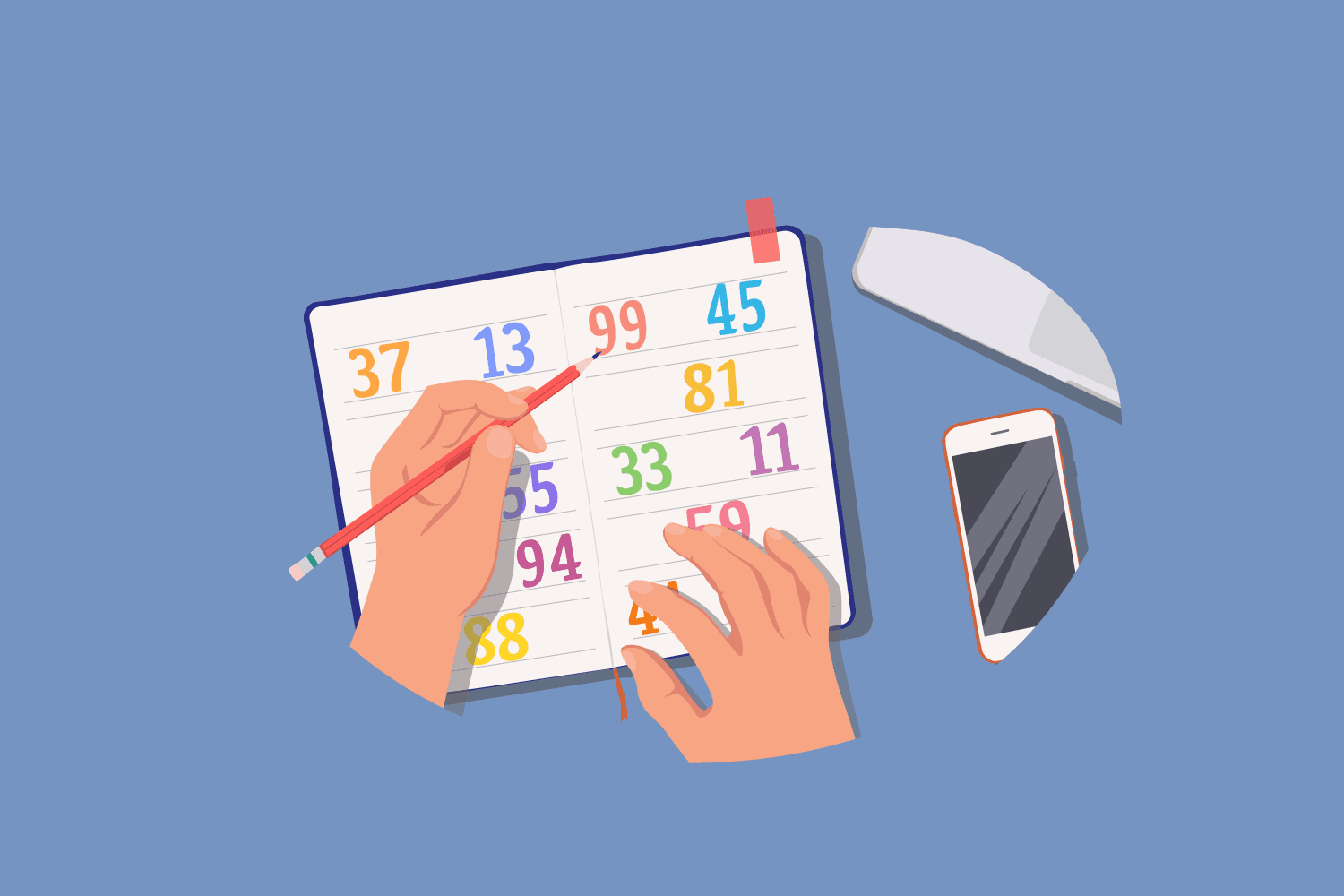How to Write Numbers in Arabic from 1 to 1,000,000

Contents
Key takeaways:
- Two different systems: There are Western Arabic numerals (0–9, the ones we use daily) and Eastern Arabic numerals (٠–٩, used in Arabic-speaking countries). They share the same historical roots but look different.
- Reading direction: Even though Arabic words are written right to left, numbers in Arabic are read left to right, just like in English.
- Reversed order in compounds: In formal Arabic, numbers like 21 follow the structure “one and twenty” instead of “twenty-one,” joined with the connector “و” (wa).
- Focus on the basics first: Beginners should start by recognizing Eastern Arabic numerals (٠–٩) and learning to pronounce numbers 1–10. More advanced grammar rules can come later.
- Avoid common mistakes: Don’t confuse similar-looking numerals (like ٤ and 3), remember to include “و” in compound numbers, and keep in mind the difference between reading numbers and words.
- Variations exist: The numeral system is the same across all Arabic-speaking countries, but pronunciation can vary by dialect. Modern Standard Arabic (MSA) is understood by all speakers.
Imagine being able to say your age, mention your birthday month, or count up to 100 in Arabic, a language spoken by over 400 million people worldwide. Learning Eastern Arabic numerals is one of the most practical first steps if you want to get familiar with this fascinating language.
In this beginner’s guide, you’ll learn the basics of Arabic numerals, discover key differences between the systems, and explore how to read and pronounce numbers from 1 all the way up to 1,000,000. Let’s get started!
Eastern vs. Western Arabic Numerals
Before we compare, let’s clear up a common confusion: “Arabic numerals” and “Arabic numbers” are not the same thing.
- Western Arabic numerals (0, 1, 2, 3, 4, 5, 6, 7, 8, 9) are the digits used internationally today, including in English. Despite the name, they were originally developed in India. More accurate terminology is “Hindu-Arabic numerals.” Arab scholars spread this system into Europe during the expansion of the Islamic world.
- Eastern Arabic numerals (٠١٢٣٤٥٦٧٨٩) are the digits used across Arabic-speaking countries and are sometimes called “Arabic-Indic numerals.”
Here are the main distinctions between the two systems:
- Writing direction: While Arabic text is written right to left, Eastern Arabic numerals are written and read left to right — just like English. However, when writing the numbers out in words, Arabic follows the usual right-to-left script.
- Building larger numbers: In English, we say “twenty-two” (tens first, then ones). In formal Arabic, the order is reversed: “two and twenty.” This is similar to how German works. In everyday speech, some speakers simplify these rules, but in formal writing the reversed order is standard.
- Pronunciation and spelling differences: The written numerals (٠–٩) are the same in every Arabic-speaking country. But when spelled out or pronounced, numbers may vary slightly by dialect. Still, all Arabic speakers understand Modern Standard Arabic (MSA – الفصحى), so these differences don’t cause misunderstandings. Also note that in some Arab countries, people use both numeral systems side by side.
Practical Tips for Learning Eastern Arabic Numbers
If you’re just starting to get familiar with Arabic numbers, here are some strategies to make the process easier:
1. Start with the basics
- Focus on memorizing the Arabic numbers from 1 to 10.
- Practice recognizing the Eastern Arabic numerals (٠–٩).
- Use flashcards or learning apps to reinforce the shape of each digit.
2. Use memorization tricks
- Compare Eastern numerals with the Western ones you already know.
- Some look similar — for example, ١ (1) and ٩ (9) resemble our digits.
- Write the numbers repeatedly to “train” your hand.
3. Practice basic pronunciation
- Begin with the numbers 1–10.
- Don’t worry about perfect pronunciation right away — just aim for familiarity.
- Whenever possible, listen to audio resources to hear how the numbers are spoken.
4. Build step by step
- After learning 1–10, move on to the tens (20, 30, 40…).
- Practice everyday numbers: ages, time, prices.
- Try using numbers in practical situations as often as possible.
Remember: Arabic grammar has many complex rules related to numbers. As a beginner, focus first on recognition and simple use. Build a solid foundation before worrying about advanced grammar details.
Now let’s look at some tables with Arabic numbers to support your learning.
Arabic Numbers 1 to 10
| Numeral | Arabic Script | Transliteration | Approx. Pronunciation |
| 0 | ٠ | صِفْر (sifr) | “sífr” |
| 1 | ١ | وَاحِد (waahid) | “wáhid” |
| 2 | ٢ | إِثْنَان (ithnaan) | “itnáan” |
| 3 | ٣ | ثَلَاثَة (thalaatha) | “taláta” |
| 4 | ٤ | أَرْبَعَة (arba‘a) | “arbáa” |
| 5 | ٥ | خَمْسَة (khamsa) | “khamsa” |
| 6 | ٦ | سِتَّة (sitta) | “sitta” |
| 7 | ٧ | سَبْعَة (sab‘a) | “sabáa” |
| 8 | ٨ | ثَمَانِيَة (thamaaniya) | “tamánia” |
| 9 | ٩ | تِسْعَة (tis‘a) | “tisáa” |
| 10 | ١٠ | عَشَرَة (‘ashara) | “áshara” |

Numbers in Arabic from 11 to 20
| Numeral | Arabic Script | Transliteration | Approx. Pronunciation |
| 11 | ١١ | أَحَدَ عَشَرَ (ahada ‘ashar) | “áhada áshar” |
| 12 | ١٢ | اثْنَا عَشَرَ (ithnaa ‘ashar) | “itnáa áshar” |
| 13 | ١٣ | ثَلَاثَةَ عَشَرَ (thalaathata ‘ashar) | “taláta áshar” |
| 14 | ١٤ | أَرْبَعَةَ عَشَرَ (arba‘ata ‘ashar) | “arbáa áshar” |
| 15 | ١٥ | خَمْسَةَ عَشَرَ (khamsata ‘ashar) | “khamsa áshar” |
| 16 | ١٦ | سِتَّةَ عَشَرَ (sittata ‘ashar) | “sitta áshar” |
| 17 | ١٧ | سَبْعَةَ عَشَرَ (sab‘ata ‘ashar) | “sabáa áshar” |
| 18 | ١٨ | ثَمَانِيَةَ عَشَرَ (thamaaniyata ‘ashar) | “tamánia áshar” |
| 19 | ١٩ | تِسْعَةَ عَشَرَ (tis‘ata ‘ashar) | “tisáa áshar” |
| 20 | ٢٠ | عِشْرُون (‘ishruun) | “íshrūn” |
Arabic Numbers: Tens (20–90)
| Numeral | Arabic Script | Transliteration | Approx. Pronunciation |
| 20 | ٢٠ | عِشْرُون (‘ishruun) | “íshrūn” |
| 30 | ٣٠ | ثَلَاثُون (thalaathuun) | “talātūn” |
| 40 | ٤٠ | أَرْبَعُون (arba‘uun) | “arbáaūn” |
| 50 | ٥٠ | خَمْسُون (khamsuun) | “khamsūn” |
| 60 | ٦٠ | سِتُّون (sittuun) | “sittūn” |
| 70 | ٧٠ | سَبْعُون (sab‘uun) | “sabāūn” |
| 80 | ٨٠ | ثَمَانُون (thamaanuun) | “tamānūn” |
| 90 | ٩٠ | تِسْعُون (tis‘uun) | “tisāūn” |
1
Examples of Compound Numbers
| Numeral | Arabic Script | Transliteration | Approx. Pronunciation |
| 21 | ٢١ | وَاحِد وَعِشْرُون (waahid wa-‘ishruun) | “wáhid wa-íshrūn” |
| 22 | ٢٢ | إِثْنَان وَعِشْرُون (ithnaan wa-‘ishruun) | “itnáan wa-íshrūn” |
| 35 | ٣٥ | خَمْسَة وَثَلَاثُون (khamsa wa-thalaathuun) | “khamsa wa-talātūn” |
| 47 | ٤٧ | سَبْعَة وَأَرْبَعُون (sab‘a wa-arba‘uun) | “sabáa wa-arbáaūn” |
| 58 | ٥٨ | ثَمَانِيَة وَخَمْسُون (thamaaniya wa-khamsuun) | “tamánia wa-khamsūn” |
| 69 | ٦٩ | تِسْعَة وَسِتُّون (tis‘a wa-sittuun) | “tisáa wa-sittūn” |
Hundreds and Thousands in Arabic
| Numeral | Arabic Script | Transliteration | Approx. Pronunciation |
| 100 | ١٠٠ | مِائَة (mi’a) | “mía” |
| 200 | ٢٠٠ | مِائَتَان (mi’ataan) | “mi‘atān” |
| 300 | ٣٠٠ | ثَلَاثمِائَة (thalaathumi’a) | “talátu mi’a” |
| 400 | ٤٠٠ | أَرْبَعمِائَة (arba‘umi’a) | “arbáu mi’a” |
| 500 | ٥٠٠ | خَمْسمِائَة (khamsumi’a) | “khamsu mi’a” |
| 1,000 | ١٠٠٠ | أَلْف (alf) | “álf” |
| 2,000 | ٢٠٠٠ | أَلْفَان (alfaan) | “alfān” |
| 10,000 | ١٠٠٠٠ | عَشَرَة آلَاف (‘ashara aalaaf) | “áshara alāf” |
| 100,000 | ١٠٠٠٠٠ | مِائَة أَلْف (mi’at alf) | “mi’at álf” |
| 1,000,000 | ١٠٠٠٠٠٠ | مِلْيُون (milyuun) | “milyūn” |
Common Mistakes When Learning Arabic Numbers
To make your learning journey smoother, here are some frequent mistakes beginners often make, and how to avoid them:
- Confusing similar-looking numerals: Some Eastern Arabic digits look a bit like Western ones but represent different values. For example, ٤ (4) can be mistaken for our 3, and ٥ (5) looks like 0 but actually means five.
- Forgetting the connector "و" (wa): In compound numbers (21, 32, 47…), don’t forget the word “and” (و). For instance, 23 is ثلاثة وعشرون (thalatha wa-‘ishruun = “three and twenty”), not just ثلاثة عشرون.
- Mixing up reading directions: Arabic numbers are read left to right, just like in English, but the words for numbers (when written out) follow the right-to-left Arabic script.
- Jumping into complex grammar too soon: As a beginner, your priority should be recognizing the numerals and practicing basic pronunciation. Leave advanced grammar rules like gender and agreement for later, once you have a solid foundation.
Learn How to Write Numbers in Arabic with Promova
Memorizing Arabic numbers may feel challenging at first, but the right tools can make it much simpler, and even fun. Promova is a language learning platform that helps you practice Arabic numbers in a practical and interactive way.
With Promova, you can enjoy:
- Short, focused lessons: Practice numbers in Arabic in just a few minutes a day with self-paced lessons that fit your schedule.
- Vocabulary tools: Reinforce your learning with flashcards and spaced repetition.
- Expert-designed content: Learn through lessons created by specialists who focus on real-life usage. Practice naturally with everyday contexts and examples.
Ready to master Eastern Arabic numerals—and much more vocabulary? Explore Promova today and make learning a part of your daily routine!
Final Thoughts
In this guide, you learned that there are two numeral systems: the Western digits we use every day, and the Eastern Arabic numerals used in Arabic-speaking countries. More importantly, you saw that starting small—by recognizing and pronouncing the Arabic numbers 1 to 10—is the most effective way to build a strong foundation.
Remember, every step forward counts. Don’t worry about mastering every complex rule at once. Even simple details, like saying “one and twenty” instead of “twenty-one,” have their own logic. The key is consistent practice and patience with yourself.
FAQ
What do numbers look like in Arabic?
Eastern Arabic numerals (٠١٢٣٤٥٦٧٨٩) are different from the digits used in English. They are written and read left to right, unlike Arabic words, which go right to left. Each number has a unique shape and is widely used across the Middle East and North Africa.
How do you count to ten in Arabic?
The Arabic numbers 1 to 10 are:
٠ (sifr / zero), ١ (waahid / one), ٢ (ithnaan / two), ٣ (thalaatha / three), ٤ (arba‘a / four), ٥ (khamsa / five), ٦ (sitta / six), ٧ (sab‘a / seven), ٨ (thamaaniya / eight), ٩ (tis‘a / nine), ١٠ (‘ashara / ten). Pronunciation may vary slightly depending on the dialect.
How many Arabic numerals are there?
There are 10 basic numerals in Arabic, just like in English: ٠ (0), ١ (1), ٢ (2), ٣ (3), ٤ (4), ٥ (5), ٦ (6), ٧ (7), ٨ (8), and ٩ (9). Numbers like 11 (١١) are formed by combining these basic digits.
What is the number 7 in Arabic?
The number 7 in Arabic is written as ٧. Its shape looks a bit like an upside-down “V” or a check mark. In Modern Standard Arabic, it’s pronounced sab‘a.



Comments